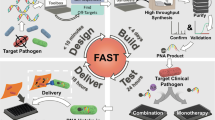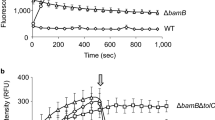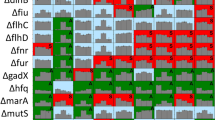Abstract
Antisense peptide nucleic acids (PNAs) can specifically inhibit Escherichia coli gene expression and growth and hold promise as anti-infective agents and as tools for microbial functional genomics. Here we demonstrate that chemical modification improves the potency of standard PNAs. We show that 9- to 12-mer PNAs, especially when attached to the cell wall/membrane-active peptide KFFKFFKFFK, provide improvements in antisense potency in E. coli amounting to two orders of magnitude while retaining target specificity. Peptide–PNA conjugates targeted to ribosomal RNA (rRNA) and to messenger RNA (mRNA) encoding the essential fatty acid biosynthesis protein Acp prevented cell growth. The anti-acpP PNA at 2 μM concentration cured HeLa cell cultures noninvasively infected with E. coli K12 without any apparent toxicity to the human cells. These results indicate that peptides can be used to carry antisense PNA agents into bacteria. Such peptide–PNA conjugates open exciting possibilities for anti-infective drug development and provide new tools for microbial genetics.
This is a preview of subscription content, access via your institution
Access options
Subscribe to this journal
Receive 12 print issues and online access
$209.00 per year
only $17.42 per issue
Buy this article
- Purchase on Springer Link
- Instant access to full article PDF
Prices may be subject to local taxes which are calculated during checkout






Similar content being viewed by others
References
Davies, J. Inactivation of antibiotics and the dissemination of resistance genes. Science 264, 375–382 (1994).
Tan, Y.T., Tillett, D.J. & McKay, I.A. Molecular strategies for overcoming antibiotic resistance in bacteria. Mol. Med. Today 6, 309–314 (2000).
Murray, R.W., Schaadt, R.D., Zurenko, G.E. & Marotti, K.R. Ribosomes from an oxazolidinone-resistant mutant confer resistance to eperezolid in a Staphylococcus aureus cell-free transcription–translation assay. Antimicrob. Agents Chemother. 42, 947–950 (1998).
Good, L. & Nielsen, P.E. Antisense inhibition of gene expression in bacteria by PNA targeted to mRNA. Nat. Biotechnol. 16, 355–358 (1998).
Good, L. & Nielsen, P.E. Inhibition of translation and bacterial growth by peptide nucleic acid targeted to ribosomal RNA. Proc. Natl. Acad. Sci. USA 95, 2073–2076 (1998).
White, D.G. et al. Inhibition of the multiple antibiotic resistance (mar) operon in Escherichia coli by antisense DNA analogs. Antimicrob. Agents Chemother. 41, 2699–2704 (1997).
Harth, G., Zamecnik, P.C., Tang, J.Y., Tabatadze, D. & Horwitz, M.A. Treatment of Mycobacterium tuberculosis with antisense oligonucleotides to glutamine synthetase mRNA inhibits glutamine synthetase activity, formation of the poly-l-glutamate/glutamine cell wall structure, and bacterial replication. Proc. Natl. Acad. Sci. USA 97, 418–423 (2000).
Nielsen, P.E., Egholm, M., Berg, R.H. & Buchardt, O. Sequence-selective recognition of DNA by strand displacement with a thymine-substituted polyamide. Science 254, 1497–1500 (1991).
Wittung, P., Nielsen, P.E., Buchardt, O., Egholm, M. & Norden, B. DNA-like double helix formed by peptide nucleic acid. Nature 368, 561–563 (1994).
Jensen, K.K., Orum, H., Nielsen, P.E. & Norden, B. Kinetics for hybridization of peptide nucleic acids (PNA) with DNA and RNA studied with the BIAcore technique. Biochemistry 36, 5072–5077 (1997).
Egholm, M. et al. PNA hybridizes to complementary oligonucleotides obeying the Watson–Crick hydrogen-bonding rules. Nature 365, 566–568 (1993).
Giesen, U. et al. A formula for thermal stability (Tm) prediction of PNA/DNA duplexes. Nucleic Acids Res. 26, 5004–5006 (1998).
Demidov, V.V. et al. Stability of peptide nucleic acids in human serum and cellular extracts. Biochem. Pharmacol. 48, 1310–1313 (1994).
Nielsen, P.E., Haaima, G. Peptide nucleic acid (PNA). A DNA mimic with a pseudopeptide backbone. Chem. Soc. Rev. 96, 73–78 (1997).
Hanvey, J.C. et al. Antisense and antigene properties of peptide nucleic acids. Science 258, 1481–1485 (1992).
Knudsen, H. & Nielsen, P.E. Antisense properties of duplex- and triplex-forming PNAs. Nucleic Acids Res. 24, 494–500 (1996).
Norton, J.C., Piatyszek, M.A., Wright, W.E., Shay, J.W. & Corey, D.R. Inhibition of human telomerase activity by peptide nucleic acids. Nat. Biotechnol. 14, 615–619 (1996).
Taylor, R.W., Chinnery, P.F., Turnbull, D.M. & Lightowlers, R.N. Selective inhibition of mutant human mitochondrial DNA replication in vitro by peptide nucleic acids. Nat. Genet. 15, 212–215 (1997).
Nikaido, H. Prevention of drug access to bacterial targets: permeability barriers and active efflux. Science 264, 382–388 (1994).
Good, L., Sandberg, R., Larsson, O., Nielsen, P.E. & Wahlestedt, C. Antisense PNA effects in Escherichia coli are limited by the outer- membrane LPS layer. Microbiology 146, 2665–2670 (2000).
Sekiguchi, M. & Iida, S. Mutants of Escherichia coli permeable to actinomycin. Proc. Natl. Acad. Sci. USA 58, 2315–2320 (1967).
Wagner, R.W., Matteucci, M.D., Grant, D., Huang, T. & Froehler, B.C. Potent and selective inhibition of gene expression by an antisense heptanucleotide. Nat. Biotechnol. 14, 840–844 (1996).
Hancock, R.E. Peptide antibiotics. Lancet 349, 418–422 (1997).
Schwarze, S.R., Hruska, K.A. & Dowdy, S.F. Protein transduction: unrestricted delivery into all cells? Trends Cell Biol. 10, 290–295 (2000).
Aldrian-Herrada, G. et al. A peptide nucleic acid (PNA) is more rapidly internalized in cultured neurons when coupled to a retro-inverso delivery peptide. The antisense activity depresses the target mRNA and protein in magnocellular oxytocin neurons. Nucleic Acids Res. 26, 4910–4916 (1998).
Pooga, M. et al. Cell penetrating PNA constructs regulate galanin receptor levels and modify pain transmission in vivo. Nat. Biotechnol. 16, 857–861 (1998).
Cutrona, G. et al. Effects in live cells of a c-myc anti-gene PNA linked to a nuclear localization signal. Nat. Biotechnol. 18, 300–303 (2000)
Vaara, M. & Porro, M. Group of peptides that act synergistically with hydrophobic antibiotics against gram-negative enteric bacteria. Antimicrob. Agents Chemother. 40, 1801–1805 (1996).
Cronan, J.E. & Rock, C.O. Biosynthesis of membrane lipids. In Escherichia coli and Salmonella: cellular and molecular biology, Edn. 2. (eds Neidhardt, F.C. & Curtiss, R.) 612–636 (American Society for Microbiology, Washington, DC; 1996).
Christensen, L. et al. Solid-phase synthesis of peptide nucleic acids. J. Peptide Sci. 1, 175–183 (1995).
Miller, J.H. Experiments in molecular genetics. (Cold Spring Harbor Press, Cold Spring Harbor, NY; 1972).
Acknowledgements
This research was supported by the Danish Biotechnology Program, Pharmacia Corporation and the Swedish Foundation for Strategic Research
Author information
Authors and Affiliations
Corresponding authors
Rights and permissions
About this article
Cite this article
Good, L., Awasthi, S., Dryselius, R. et al. Bactericidal antisense effects of peptide–PNA conjugates. Nat Biotechnol 19, 360–364 (2001). https://doi.org/10.1038/86753
Received:
Accepted:
Issue Date:
DOI: https://doi.org/10.1038/86753
This article is cited by
-
Peptide nucleic acid conjugates and their antimicrobial applications—a mini-review
European Biophysics Journal (2023)
-
Artificial genetic polymers against human pathologies
Biology Direct (2022)
-
Amphipathic dendritic poly-peptides carrier to deliver antisense oligonucleotides against multi-drug resistant bacteria in vitro and in vivo
Journal of Nanobiotechnology (2022)
-
Scaffold size-dependent effect on the enhanced uptake of antibiotics and other compounds by Escherichia coli and Pseudomonas aeruginosa
Scientific Reports (2022)
-
Translocation of non-lytic antimicrobial peptides and bacteria penetrating peptides across the inner membrane of the bacterial envelope
Current Genetics (2022)



